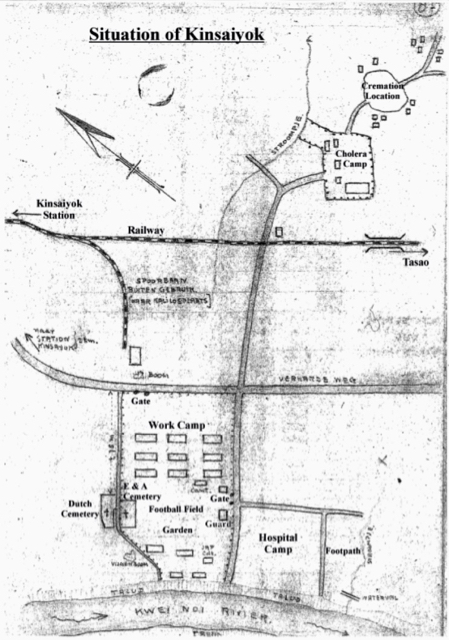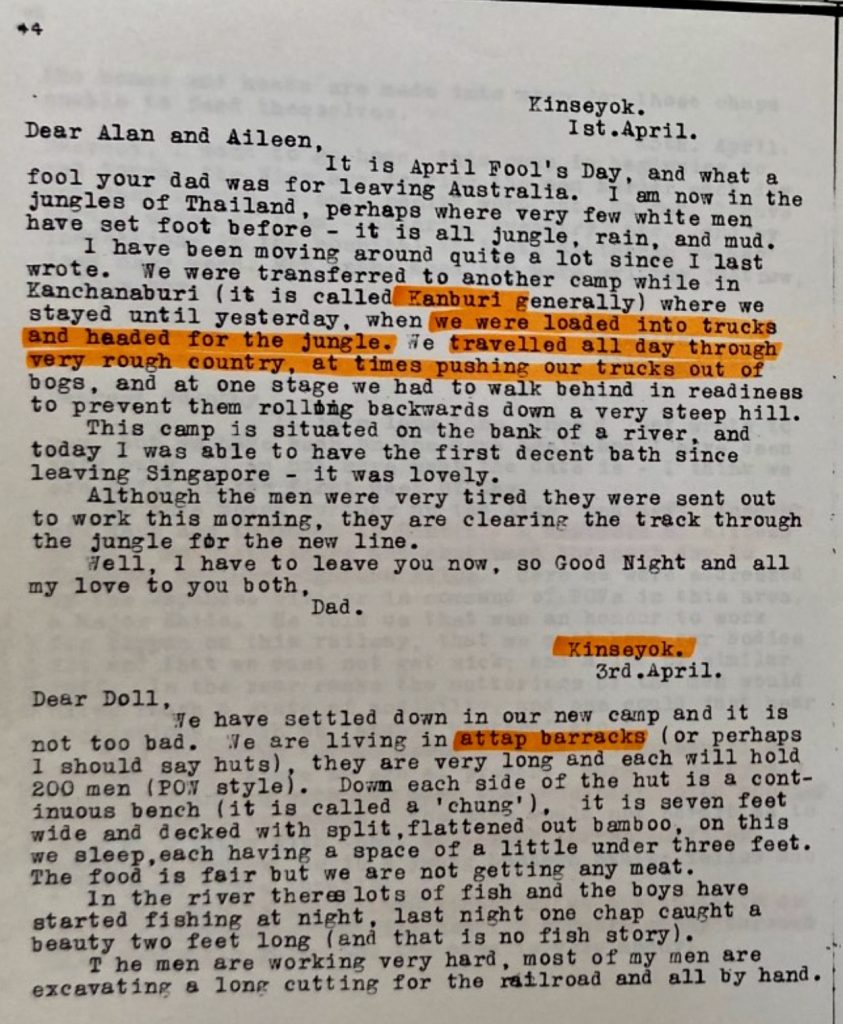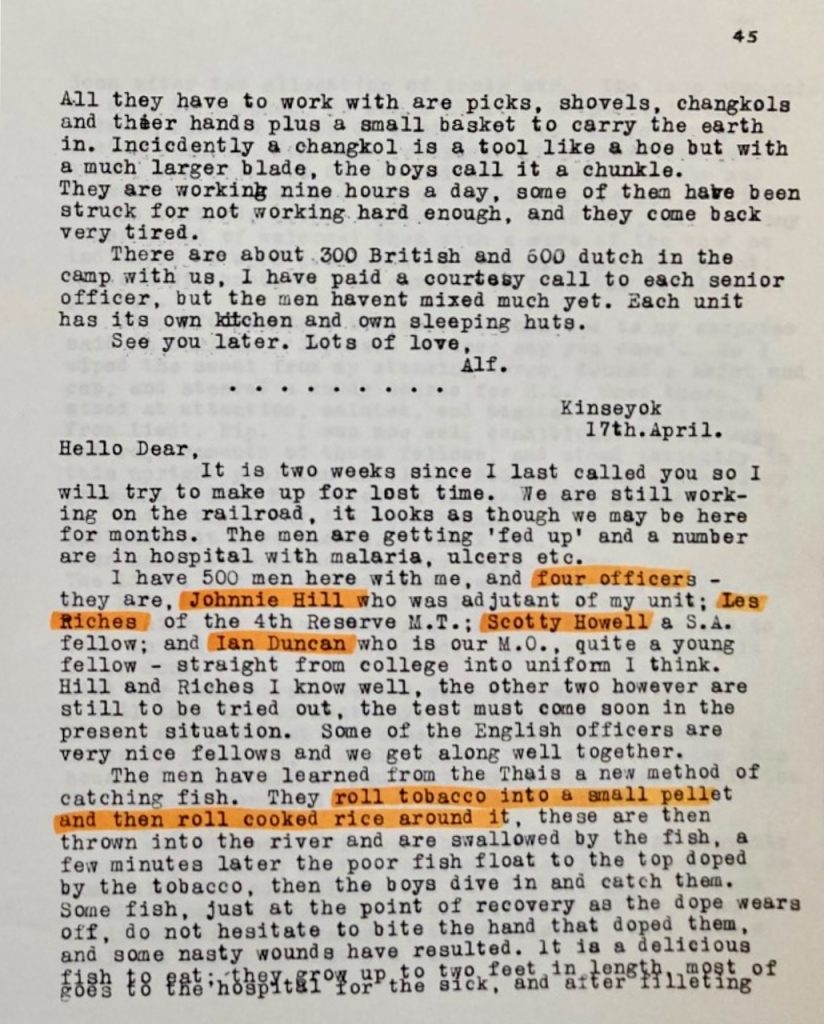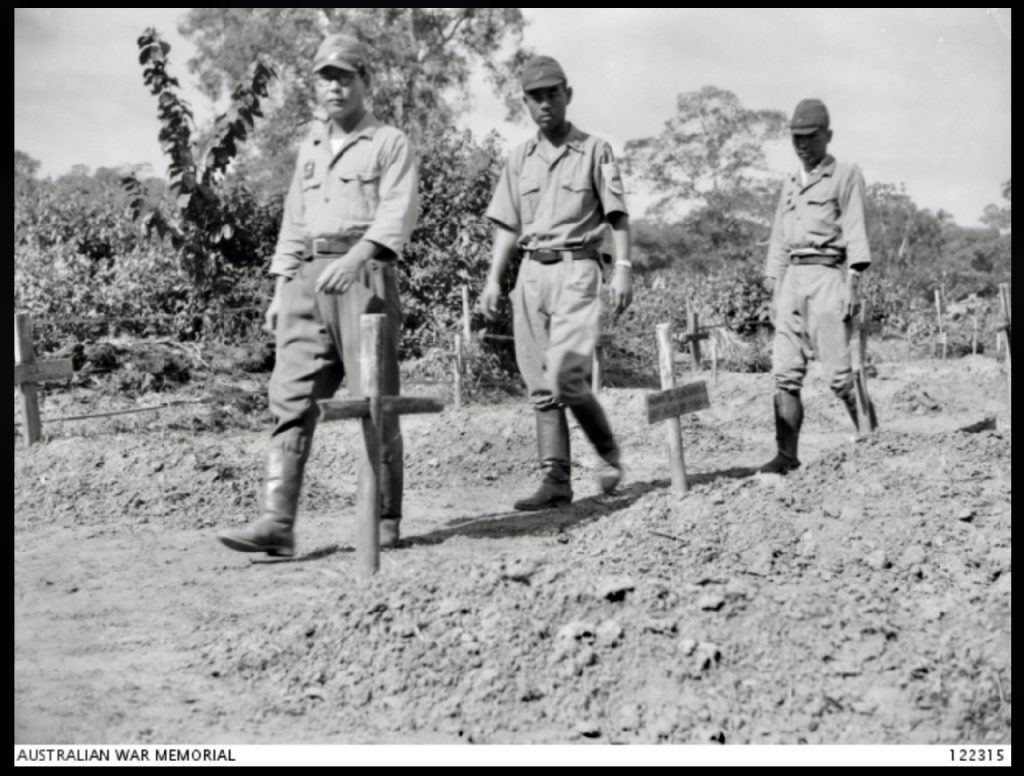Kinsaiyok Main, 170.2k - Thailand
Kinsaiyok Main, 170.2k – Thailand
‘D’ Force V Battalion Group 6 were at Kinsaiyok Camp 31 March 1943 to 1st May 1943
Major Cough’s V Battalion at this time consisted of 5 officers and 482 other ranks. Of all the ‘D’ Force Battalions, fate would deal out a heavy blow to this group. Tom Cough at this time was not yet 21 years old.

On 31 March V Battalion arrived Kinsaiyok which was already occupied by 300 British and 600 Dutch prisoners. This particular Kinsaiyojk camp was situated on the bank of River Kwae Noi with atap huts housing 200 men each. Along the side of each hut was a long bench called a chung. It was about 7 feet wide and made of flattened bamboo on which the men slept.
The first task at Kinsaiyok was to cut a track through the jungle ahead of rail laying gangs and the excavation of a long cutting.
7 men died during the 32 day stay.
Read more about movements of V Battalion
On 2nd May V Battalion was on the move north, staging overnight at Rin Tin Camp. The following day they set out to Hindato Camp 197.75 km point where they stayed overnight. Hindato was the HQ for ‘D’ Force Group 6 under the command of Major Shida. The following day V Battalion marched another 10 kilometres to Brankassi Camp arriving 5 May 1943.
Weary Dunlop arrived Kinsaiyok September 1943 and found the hospital disorganised with the different nationalities running their own wards and a terrible muddle.
He organised the construction of a new hospital with a dedicated kitchen, an operating theatre with earthen floor and longitudinal bamboo platforms for bedding with passages to allow medical staff access to patients. Dunlop also organised the pooling of medical supplies and a camp fund to buy food for the sick.
Unfortunately for Kinsaiyok Dunlop left for Tarsau on 25 October 1943. He had however implemented all the changes by then.
A small hospital continued to be maintained at Kinsaiyok until 1945, serving the groups maintaining the railway. Kinsaiyok had three cemeteries with around four hundred graves.
WX10802 OUTTRIM,
 Corporal Noel James
Corporal Noel James
died 22 Nov 1944 cerebral malaria aged 24 years. (was with Capt Fred Harris Party, ‘D’ Force – presumably he returned to Kinsaiyok with a maintenance Party).
Noel’s name is included on the Mundaring WWII Memorial Please read further.
With various Kinsaiyok camps, it is difficult to decided which camp Alf Cough was at.


In Borehole Bulletin October 1992
‘REPORTS ON VARIOUS CAMPS’
POW Dr. I L Duncan gave very graphic descriptions of three camps on Thai-Burma Railway. Annexure ‘B’.
KINSAIYOK
This was a camp with bamboo and attup huts that had been used by other parties. The huts were very dilapidated and infested with lice and bed bugs and sited close to River Kwai. Conditions in the camp were very primitive and the men forced to do very heavy work building the railway embankment. Food was minimal – mainly rice with dried seaweed or daicon added. Occasionally a small amount of dried fish was obtained.
Medical facilities consisted of a hospital hut but there were virtually no medical supplies. All hospital admissions had to be approved by Japanese NCO in charge of the camp.’
Dr Duncan also provided description of Hindaine and Brankassi Camps.
In addition he wrote:
‘The picture in respect of each (camp) is largely the same. Cholera arose in Hindaine – the Japanese insisted that 75% of total camp strength be sent out to work. Where the number fell under this figure the men were actually beaten to work.
The nature of the work was extremely hard, food and diet was minimal and at Brankassi the nature of sickness broadened – malaria, beri beri, pellagra, various diarhoeas, tropical ulcers, pneumonia and dengue fever.’

Kinsayok, Thailand. 20 October 1945. Three of the Japanese maintenance party moving past Australian graves in one of the three cemeteries at Kinsayok on the Burma-Thailand railway, approximately 170 kilometres north of Nong Pladuk (also known as Non Pladuk). During the September-October period of 1945, the War Graves Commission survey party was given the task of locating prisoner of war (POW) cemeteries and grave sites along the Burma-Thailand railway. As part of this programme the Japanese army was ordered to provide personnel to assist in locating and clearing these sites, and maintaining them until the bodies could be exhumed for re-burial in the war cemeteries at Chungkai, Kanchanaburi and Thanbyuzayat. Over 13,000 Australian POWs worked on the railway of whom in excess of 2,000 died as a result of their harsh working conditions.

Above: Lance Barnett left with Capt Fred Harris Party.
